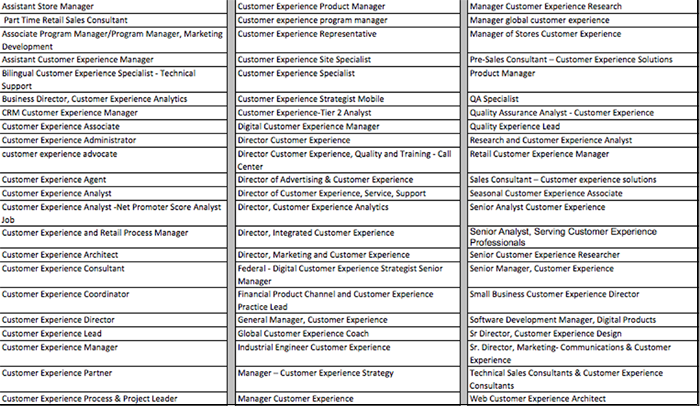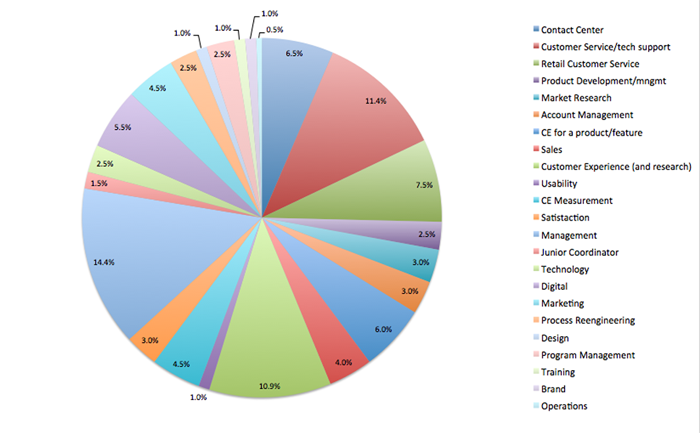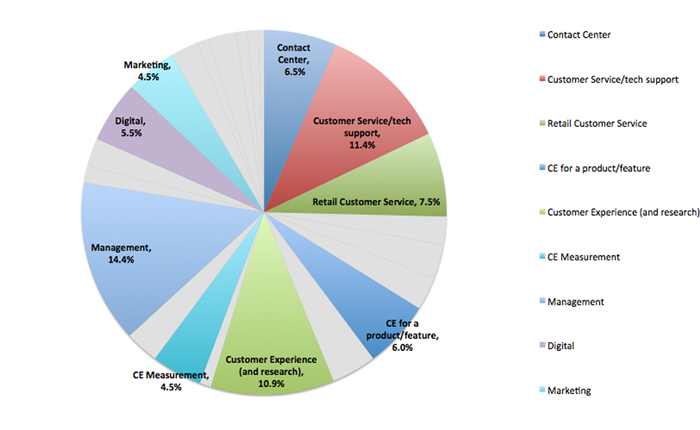Recently Ceatro did a quick survey of 102* unique listings for jobs that matched a “customer experience” search from three leading job hunting sites to understand what types of roles were being called “customer experience” jobs.
We did this survey because we wanted to see how the phrase “customer experience” was being used and for what type of roles. We hypothesized that if so few organizations had actually implemented customer experience practices (see our definition here) there couldn’t be as many jobs available for customer experience as we saw posted.
One of things we were seeing in lots of areas of our field – in articles, in conversations, in presentations – was the use of the phrase “customer experience” to mean so many different things. We hypothesized that a lot of jobs that used to be titled or defined as something else were now being re-titled or redefined “customer experience” because it made organizations seem more in touch with its customers.
Here is what we found:
66 Unique Titles from 102 jobs
We were excited to see so many jobs focused on customer experience!
But, as we expected, the titles were misleading. The ‘intent’ of these jobs were quite diverse even though they had relatively similar titles and/or use of the phrase ‘customer experience.’ After we read through these for a while we began to feel like many organizations were just sticking “customer experience” in front of other job titles because ultimately every job in a company eventually impacts the the customers’ experience!
We read through each job and coded it for its intent. We allowed multiple intents for each job in order to accurately capture the tasks and purpose of the job. A note on methodology: On average each job at two intents, totally 23 different types of intents, and 202 total. We defined the intents as we went along since we weren’t sure what we were going to find. In the end we made a final pass through all 102 jobs to reaffirm the coding and reassign intents as necessary.
Breakdown of All Job Intents
That’s a lot of variety. The concentration of these jobs are in the following areas: Contact Centers, Customer Service/Tech Support, Retail Customer Services, Marketing, Digital, Management (non-exclusive category, clearly), customer experience overall including research, customer experience for a specific product or feature, and customer experience metrics.
Although our survey couldn’t help us understand what an organization’s intent in re-titling or redefining traditional service and marketing roles with the customer experience moniker, this is exactly what we found.
We separated management out into its own category (14.4%) since it always had a second intent in our reviews. We then grouped the three customer experience categories that related directly to our definition of customer experience – customer experience overall including research, customer experience for a specific product or feature, and customer experience metrics (26.4%). And that left 59% of the roles which had intents that lead us to believe they used to be titled or defined as something else.
Specifically we say an abundance of retail sales jobs, retail management jobs, and retail banking roles that used to be defined as “sales associate” now being titled or defined as “customer experience lead” or “customer experience associate.” We also saw a large number of call center or contact center or tech support jobs being titled or defined as a “customer experience agents” or “customer experience representatives. And though we included them in the 26.4% of jobs that were related to customer experience the practice, we reviewed a number of data analyst roles that were newly titled or defined as “customer experience analysts” if the data at all involved customers.
To drive this point, we actually encountered more than 10 jobs out of 102 that had a second job title to explain the first one, in case “customer experience something” didn’t make sense, or a second title in the body of the description that hadn’t been properly changed when it was re-titled. For example: customer experience manager was subtitled customer service manager, customer experience consultant was previously specialist, business project management.
As usual we got to the end of this exercise and ask ourselves the questions we often ask: Does it matter? Is this just semantics? And we came up with the answer we usually come to: Yes, it does matter both to the development of the customer experience space and to the outcomes organizations hope to get by having a customer experience practice. It also becomes much harder to hire for specific customer experience skill sets if there are so many jobs with the title and it means different things.
*Why 102 and not 100? When we finished we were two over our target so we kept the extra two in the data.




